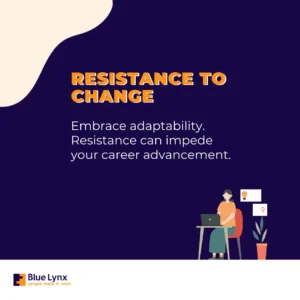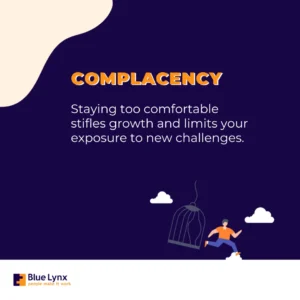9 Things That Can Ruin Your Career

Our actions, habits, and mindset play a profound role in shaping the trajectory of our careers. Self-sabotaging behaviours often impede our progress and potential.
This article aims to shed light on the profound impact of these behaviours on our careers and provide a strategic guide to overcoming them.
Negativity
What is a negative mindset in the workplace?
A negative mindset not only affects individual well-being but also disrupts team dynamics and organisational culture. In the workplace, constant complaints, a pessimistic outlook, and a general lack of enthusiasm can create an oppressive environment for creativity, collaboration and productivity.
To understand the extent of negativity’s impact, we’ll explore real-world examples of negative attitudes that manifest at the workplace.
From chronic complaining to an unrelenting focus on problems rather than solutions, these behaviours can become significant barriers to progress.
A negative mindset at work can manifest in diverse behaviours and attitudes that impact our productivity, relationships, and overall well-being.

By recognising these expressions, we can learn how to stop thinking negatively at work and transform our mindset.
Here are 9 examples of a negative mindset in the workplace:
- Constant Complaining
An employee who is consistently dissatisfied with tasks, projects, or colleagues, creating a toxic atmosphere and dampening team morale.
- Resistance to Change
Resisting new processes, technologies, or organisational changes, hindering innovation and impeding the company’s ability to adapt to evolving trends.
- Blaming
Someone who habitually shifts blame to colleagues or external factors for their own mistakes or shortcomings, fostering a culture of defensiveness and hampering accountability.
- Pessimism
An employee who consistently anticipates negative outcomes, even in situations with potential for success, creating an environment where opportunities may be overlooked or dismissed prematurely.
- Lack of Initiative
A team member who consistently avoids taking on new responsibilities or challenges, exhibiting a lack of motivation and hindering personal and team growth.
- Gossiping and Rumor-Spreading
Engaging in negative conversations about colleagues or spreading unfounded rumors, contributing to a toxic work environment and eroding trust among team members.
- Micromanaging
A manager who shows a lack of trust in their team by excessively monitoring and controlling every aspect of their work, leading to frustration and diminished employee autonomy.
- Closed-Mindedness
A colleague who consistently dismisses new ideas or suggestions without consideration, stifling creativity and thwarting a culture of innovation.
- Inability to Accept Constructive Feedback
Responding defensively or negatively to constructive criticism, hindering personal growth and impeding the development of effective working relationships.
It’s important to note that occasional negative thoughts are natural. However, a persistent negative mindset can significantly impact both individual and team success.
Recognising and addressing such behaviours is key to fostering a positive work environment and personal growth.
Cultivating a Positive Outlook in the Workplace
Negativity, though pervasive, is not unconquerable. In this segment, we’ll discuss actionable strategies for cultivating a positive outlook that acts as a catalyst for professional success.
From fostering a mindset of gratitude to reframing challenges as opportunities, you can proactively transform your mindset.
Additionally, we’ll explore techniques for maintaining resilience in the face of setbacks and fostering a work environment where positivity becomes a collective strength.
By embracing these strategies, you can actively counteract the effects of negativity, setting the stage for a more fulfilling and successful career journey.
Here you can browse 8 strategies that will help you shift your perspective and change your life for the better:
- Practice Gratitude
Begin or end each workday by reflecting on three things you’re grateful for. This simple practice can shift your focus toward the positive aspects of your professional life.
- Surround Yourself with Positivity
Engage with colleagues who are positive and just genuinely pleasant to be around. Surrounding yourself with people who help uplift your outlook.
- Reframe Challenges as Opportunities
Instead of viewing challenges as obstacles, see them as opportunities for growth and learning. This shift in perspective can empower you to approach difficulties with a positive mindset.
- Focus on Solutions, Not Problems
When faced with challenges, concentrate on finding solutions that are within your control, rather than dwelling on the problems that you have no power over. Taking a proactive stance reinforces a problem-solving mindset and diminishes negativity.
- Express Appreciation
Regularly express appreciation to your colleagues. A simple “thank you” or a token of acknowledgement of their efforts can create a positive and supportive work environment.
- Learn from Setbacks
Instead of viewing setbacks as failures, see them as opportunities to learn and improve. Analyze what went wrong, adjust your approach, and move forward with newfound knowledge.
- Balance Work and Life
Strive for a healthy work-life balance. Make time for activities you enjoy outside of work, whether it’s hobbies, exercise, or spending time with loved ones. A well-rounded life contributes to a positive mindset.
- Celebrate Achievements
Acknowledge and celebrate your achievements, no matter how small. Recognising your accomplishments reinforces a positive self-perception and motivates further success.
Low Emotional Intelligence
Emotional intelligence (EI) is the key to effective interpersonal relationships and professional success. In the workplace, where collaboration, communication, and adaptability are paramount, people with high emotional intelligence thrive.
The significance of emotional intelligence in the workplace cannot be overstated.
According to the Harvard Division of Continuing Education, emotional intelligence accounts for nearly 90% of what moves people up the ladder when IQ and technical skills are roughly similar.
It fosters a positive work culture, enhancing team dynamics, and facilitating successful leadership.
Employees with high emotional intelligence possess a heightened ability to understand and manage their own emotions, breeding self-awareness and emotional regulation.
However, the true strength of emotional intelligence lies in its capacity to navigate intricate social scenarios with finesse. Such people excel in understanding the emotions of their colleagues, which creates empathetic connections that contribute to a harmonious work environment.

What is more, in team settings, high emotional intelligence becomes a catalyst for effective communication, conflict resolution, and collaboration, resulting in improved group dynamics and overall productivity.
As far as leadership is concerned, emotional intelligence is pivotal. Leaders who can empathise with their team members, manage conflicts with tact, and inspire through effective communication are better positioned to guide their teams toward shared goals.
Thus, the cultivation of emotional intelligence emerges as a cornerstone for creating a positive workplace environment driven by effective leadership.
How do we identify and deal with low emotional intelligence?
Recognising signs of low emotional intelligence is essential to confront and rectify such behaviours.
In the workplace, these signs may manifest as a lack of empathy, difficulty in understanding others’ perspectives, and an inability to manage emotional reactions constructively.
Colleagues may notice a lack of social awareness, characterised by an inability to gauge the emotional climate of the team or an obliviousness to the impact of one’s actions on others.
By pinpointing these indicators, you can take the first step towards self-improvement and personal growth.
How to Improve Emotional Intelligence
Improving emotional intelligence is a transformative journey that enhances interpersonal relationships, communication skills, and overall well-being.
A study by the University of California, Berkeley found that people who participated in a 10-week emotional intelligence training program showed significant improvements in their self-awareness, self-management, social awareness, and relationship management skills.
Here are 5 ways to improve emotional intelligence:
- Fostering self-awareness
Regularly reflecting on and understanding one’s own emotions lays the foundation for emotional intelligence
- Embracing active listening
Facilitates empathetic connections, allowing people to understand others’ perspectives and respond thoughtfully.
- Developing emotional regulation skills
Enables individuals to manage stress and navigate challenging situations with composure.
- Cultivating empathy
Involves recognising and reading the emotions of others, promoting a deeper understanding in personal and professional interactions.
- Honing effective communication skills
Expressing emotions clearly and authentically fosters open and constructive dialogue.
Resistance to Change
Resistance to change stands as a formidable barrier to career advancement.
This can manifest in various forms, from reluctance to adopt new technologies to discomfort with shifts in organisational structure.
What is apparent, is that those who resist change may find themselves left behind in a rapidly progressing environment. Career growth often hinges on the ability to adapt and embrace innovation, and resistance can significantly hinder one’s professional journey.

Common Reasons for Resistance and Their Consequences
Resistance to changes in the workplace is rooted in the natural human inclination for stability and familiarity.
It manifests when employees or groups react adversely to alterations in organisational processes, structures, or technologies.
This resistance can stem from various sources, including fear of the unknown, concerns about job security, or a perceived loss of control which is why 70% of change initiatives fail, according to Harvard Business Review.
Resistance stands in the way of the smooth adoption of innovations and may impede organisational progress. The consequences include a decline in employee morale, increased stress, and a reluctance to embrace new growth opportunities.
Effectively addressing resistance to change requires transparent communication, engaging employees in the change process, and emphasising the benefits and opportunities that the changes bring. By understanding and managing resistance, organisations can navigate transitions more smoothly, fostering a culture of adaptability and ensuring long-term success.
Strategies for adapting to change in the workplace
Adapting to change in the workplace is a multifaceted process that involves not only embracing new systems or structures but also cultivating a positive mindset among employees.
Effective strategies for navigating workplace changes encompass both organisational and individual levels.
Clear and transparent communication
Leaders should articulate the reasons for change, the expected benefits, and how it aligns with the organisation’s vision. Additionally, involving employees in the change process, seeking their input, and addressing concerns fosters a sense of ownership and reduces resistance.
Comprehensive training and support
Especially during the transition period helps employees develop the necessary skills to navigate the changes. Encouraging a culture of continuous learning reinforces adaptability. Recognising and celebrating small victories along the way creates a positive atmosphere, reinforcing the idea that change can lead to success.
Fostering resilience is crucial
Employees should be encouraged to view change as an opportunity for personal and professional growth. Mindfulness and stress management techniques can assist in coping with uncertainties. Furthermore, leaders should actively model adaptability, showcasing a positive attitude towards change and demonstrating the expected behaviours.
Creating a supportive and collaborative work environment
Encourages open communication and mutual assistance during times of change. By combining these strategies, organisations can build a resilient workforce capable of not only adapting to change but also thriving in dynamic and evolving work environments.
Complacency
Becoming too comfortable in one’s current role can be dangerous for both the employee and the organisation as a whole.
When employees settle into a routine and resist seeking new challenges or obtaining new skills, their personal and career growth may reach a plateau. This lack of growth not only curbs individual development but can also impact the organisation’s overall capacity for innovation and adaptation.
Complacency can lead to a decrease in motivation and job satisfaction. When people no longer feel challenged or engaged in their work, their enthusiasm declines, potentially resulting in decreased productivity and lower-quality outputs.

This lack of motivation can also contribute to increased absenteeism and higher turnover rates as employees seek more stimulating opportunities elsewhere.
Furthermore, an overly comfortable mindset can foster resistance to change, and to be competitive in the job market, adaptability is crucial.
Employees who resist change may find it challenging to adjust to new technologies, methodologies, or organisational structures, putting both their careers and the organisation at a disadvantage.
Stroking Your Boss’s Ego
While acknowledging and appreciating one’s superiors is a common professional practice, stroking your boss’s ego, can become a significant career threat.
Mostly because it creates an atmosphere of insincerity as your colleagues may perceive you as disingenuous, and eroding trust within the team.
Moreover, excessive flattery may lead to a lack of credibility; if every idea or decision is met with excessive praise, it becomes harder to distinguish genuine support. This dynamic can undermine the meritocracy of the workplace, hindering fair recognition and advancement based on actual contributions.
Navigating workplace dynamics without compromising your integrity requires a delicate balance between respect and authenticity.

Rather than excessive flattery, focus on the genuine acknowledgement of your boss’s strengths and achievements. Offer constructive feedback when necessary, demonstrating that your input is thoughtful and considered.
Building relationships based on mutual respect, shared values, and open communication is far more sustainable than a superficial approach of constant flattery.
By contributing meaningfully to discussions, providing valuable insights, and maintaining your professional integrity, you build a more authentic and professional self.
Inflatable Ego
An inflated ego, often disguised as confidence, can undermine your professional journey.
It often accompanies a distorted self-perception that can have negative consequences.
Employees with an overly inflated sense of self-importance may exhibit arrogance, dismissiveness, and an overall lack of receptivity to others’ perspectives.
Moreover, an inflated ego can hinder personal growth by creating a barrier to feedback, hindering the individual’s ability to learn and adapt in a dynamic professional environment.
What is an example of an inflated ego?
Egotistical behaviours can manifest in various forms, creating distance in professional relationships and undermining team cohesion.
Examples include taking credit for others’ achievements, dismissing alternative viewpoints, micromanaging colleagues, and consistently seeking the spotlight.
Such behaviours not only erode trust but also create a toxic work environment where collaboration becomes challenging. The egotist’s focus on self-promotion often overshadows the collective achievements of the team, leading to resentment and diminished morale among colleagues.
How do you balance humility and ego?
Cultivating humility is essential for counteracting the negative effects of an inflated ego.
Strategies include actively seeking feedback, acknowledging the contributions of others, and embracing a growth mindset that values learning from every experience.
Building collaborative work environments involves fostering open communication, valuing diverse perspectives, and recognising that collective success is more sustainable and rewarding than individual acclaim.
Leaders, in particular, play a crucial role in setting the tone for humility by modelling a collaborative approach, sharing credit, and creating an inclusive culture that celebrates the strengths of every team member.
To Sum It Up
These self-sabotaging behaviours emphasise the key role of our actions, habits, and mindset in shaping the trajectory of our careers.
Ranging from negativity and resistance to change to an inflated ego, they underscore the profound impact they can have on individual well-being, team dynamics, and organisational culture.
Being aware of the consequences of these behaviours and having strategic guides for overcoming them, gives you the tools to empower yourself, recognise and address self-sabotage, fostering personal growth and a positive work environment.
What is more, you will be able to benefit from the transformative power of cultivating a positive outlook, enhancing emotional intelligence, navigating change effectively, and embracing humility to build collaborative and successful careers.
The call to action is clear: self-reflection and proactive efforts to overcome self-sabotaging behaviours are crucial steps toward a fulfilling and prosperous professional journey.
